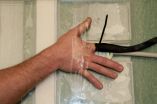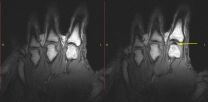(Press-News.org) EDMONTON, AB (April 12, 2015) -- "Pull my finger," a phrase embraced by school-aged kids and embarrassing uncles the world over, is now being used to settle a decades-long debate about what happens when you crack your knuckles.
In a new study published April 15 in PLOS ONE, an international team of researchers led by the University of Alberta used MRI video to determine what happens inside finger joints to cause the distinctive popping sounds heard when cracking knuckles. For the first time, they observed that the cause is a cavity forming rapidly inside the joint.
"We call it the 'pull my finger study'--and actually pulled on someone's finger and filmed what happens in the MRI. When you do that, you can actually see very clearly what is happening inside the joints," explained lead author Greg Kawchuk, a professor in the Faculty of Rehabilitation Medicine.
Scientists have debated the cause of joint cracking for decades, dating back to 1947 when U.K. researchers first theorized vapour bubble formation as the cause. That was put in doubt in the 1970s when another team of scientists instead fingered collapsing bubbles as the cause.
The idea for the project was born when Nanaimo chiropractor Jerome Fryer approached Kawchuk about a new knuckle-cracking theory. They decided to skip the theories and, with U of A colleagues Jacob Jaremko, Hongbo Zeng, Richard Thompson and Australian Lindsay Rowe, decided to actually look inside the joint.
But to find an answer, the team needed someone capable of cracking knuckles on demand--a job that fell to Fryer himself. Kawchuk said most people have the ability to crack their knuckles, but unlike most, Fryer can do it in every finger, and after the standard recuperation time, he can do it again.
"Fryer is so gifted at it, it was like having the Wayne Gretzky of knuckle cracking on our team," says Kawchuk.
Fryer's fingers were inserted one at a time into a tube connected to a cable that was slowly pulled until the knuckle joint cracked. MRI video captured each crack in real time--occurring in less than 310 milliseconds.
In every instance, the cracking and joint separation was associated with the rapid creation of a gas-filled cavity within the synovial fluid, a super-slippery substance that lubricates the joints.
"It's a little bit like forming a vacuum," Kawchuk said. "As the joint surfaces suddenly separate, there is no more fluid available to fill the increasing joint volume, so a cavity is created and that event is what's associated with the sound."
Cracking knuckles a sign of healthy joints?
More than settling a scientific curiosity, the findings pave the way for new research into the therapeutic benefit or harm of joint cracking, explained Kawchuk, a PhD in bioengineering and expert in spinal structure and function.
Scientists have calculated that the amount of force at work when you crack your knuckles has enough energy to cause damage to hard surfaces, yet research also shows that habitual knuckle cracking does not appear to cause long-term harm. Those conflicting results are something Kawchuk and his team plan to investigate next.
"The ability to crack your knuckles could be related to joint health," said Kawchuk, who believes this work could have implications for other joints in the body, including the spine, and help explain why joints become arthritic or injured.
In addition to solving the riddle of finger cracking, the team's data revealed the presence of a white flash that appears just before cracking. No one has observed it before, says Kawchuk, an occurrence he believes is water suddenly being drawn together just before the joint cracks. Kawchuk said he'd like to use even more advanced MRI technology to understand what happens in the joint after the pop, and what it all means for health.
"It may be that we can use this new discovery to see when joint problems begin long before symptoms start, which would give patients and clinicians the possibility of addressing joint problems before they begin."
INFORMATION:
NOTE TO EDITORS: An MRI video of the knuckle cracking procedure is available on YouTube. Still images can be downloaded. Please credit the University of Alberta. Greg Kawchuk is currently on sabbatical and based in Hong Kong.
For more information:
Greg Kawchuk
Professor
Faculty of Rehabilitation Medicine
University of Alberta
+852 9461 2671 (Hong Kong)
greg.kawchuk@ualberta.ca
Bryan Alary
Director, Marketing and Communications
Faculty of Rehabilitation Medicine
University of Alberta
1-780-492-9403 (Mountain Daylight Time)
bryan.alary@ualberta.ca
Faster increases in life expectancy do not necessarily produce faster population aging, according to new research published in the journal PLOS ONE. This counterintuitive finding was the result of applying new measures of aging developed at IIASA to future population projections for Europe up to the year 2050.
"Age can be measured as the time already lived or it can be adjusted taking into account the time left to live. If you don't consider people old just because they reached age 65 but instead take into account how long they have left to live, then the faster the ...
The ability to make a Lower Paleolithic hand axe depends on complex cognitive control by the prefrontal cortex, including the "central executive" function of working memory, a new study finds.
PLOS ONE published the results, which knock another chip off theories that Stone Age hand axes are simple tools that don't involve higher-order executive function of the brain.
"For the first time, we've showed a relationship between the degree of prefrontal brain activity, the ability to make technological judgments, and success in actually making stone tools," says Dietrich ...
BALTIMORE, MD, April 15, 2015 - Personal Genome Diagnostics, Inc. (PGDx), a provider of advanced cancer genome analysis and testing services, today announced the publication of a landmark study showing that many of the genetic alterations identified using tumor-only sequencing are not actually associated with the cancer, but instead reflect inherited germline mutations already present in the normal cells of the individual. The study is in the April 15 edition of Science Translational Medicine1 and was conducted by PGDx scientists working in collaboration with company co-founders ...
A study by Johns Hopkins scientists strongly suggests that sequencing tumor genomes for clues to genetic changes might misdirect treatment in nearly half of all patients unless it is compared first to a genetic readout of their noncancerous tissue.
The investigators at the Johns Hopkins Kimmel Cancer Center say their analysis of more than 800 cancer patients' sequencing data, which was generated by Personal Genome Diagnostics Inc., a company co-founded by the researchers, shows that without such comparisons, attempts to individualize cancer therapy may be inappropriate ...
How fast is online learning evolving? Are wind turbines a promising investment? And how long before a cheap hoverboard makes it to market?
Attempting to answer such questions requires knowing something about the rate at which a technology is improving. Now engineers at MIT have devised a formula for estimating how fast a technology is advancing, based on information gleaned from relevant patents.
The researchers determined the improvement rates of 28 different technologies, including solar photovoltaics, 3-D printing, fuel-cell technology, and genome sequencing. They ...
NEW YORK (April 15, 2015) -- Technological advances are enabling scientists to sequence the genomes of cancer tumors, revealing a detailed portrait of genetic mutations that drive these diseases. But genomic studies are only one piece of the puzzle that is precision medicine, a Weill Cornell Medical College researcher writes in Nature. In order to realize the promise of this field, there needs to be an increased focus on creating robust clinical databases that include medical histories from patients around the country, which physicians can then use along with genomic data ...
The long-forecasted El Niño event of 2014/15 did not meet expectations. On March 5, 2015, the National Weather Service finally declared a "weak" event arriving several months later than expected, formally dashing predictions that we would see a major event on par with the monster El Niño of 1997/98 that would bring much-needed rain to California and other western states. Now, a team of researchers believes that they know why this year's event--and others like it--didn't live up to the hype.
A new study published online April 13, 2015, in the journal Nature ...
Neuroscientists at NYU Langone Medical Center have discovered how the powerful brain hormone oxytocin acts on individual brain cells to prompt specific social behaviors - findings that could lead to a better understanding of how oxytocin and other hormones could be used to treat behavioral problems resulting from disease or trauma to the brain. The findings are to be published in the journal Nature online April 15.
Until now, researchers say oxytocin -- sometimes called the "pleasure hormone" -- has been better known for its role in inducing sexual attraction and orgasm, ...
Previous studies have suggested that pulses of icebergs may have caused cycles of abrupt climate change during the last glacial period by introducing fresh water to the surface of the ocean and changing ocean currents, which are known to play a dominant role in the climate of many of Earth's regions.
However, new findings by scientists at Cardiff University present a contradictory narrative and suggest that icebergs generally arrived too late to trigger marked cooling across the North Atlantic.
Abrupt climate change, characterised by transitions between warm and cold ...
COLUMBIA, Mo. - Invasive pests known as spruce bark beetles have been attacking Alaskan forests for decades, killing more than 1 million acres of forest on the Kenai Peninsula in southern Alaska for more than 25 years. Beyond environmental concerns regarding the millions of dead trees, or "beetle kill" trees, inhabitants of the peninsula and surrounding areas are faced with problems including dangerous falling trees, high wildfire risks, loss of scenic views and increased soil erosion. Now, a researcher from the University of Missouri and his colleagues have found that ...


